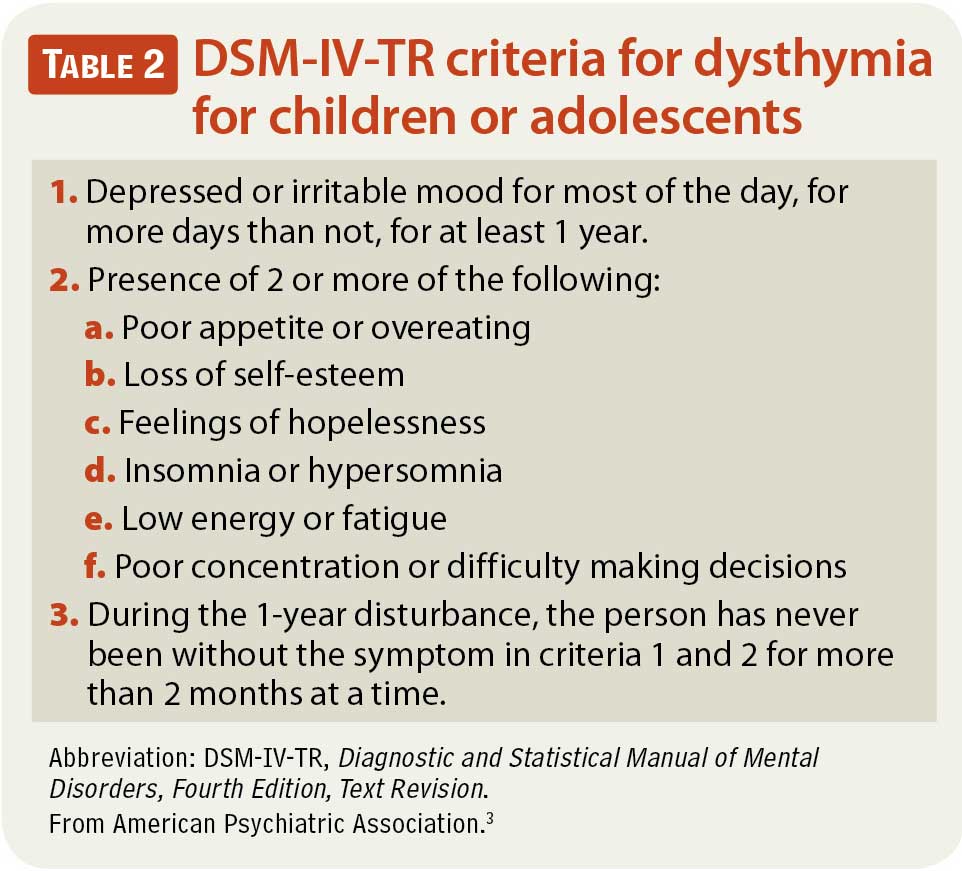
+–+DSM+V.jpg)
Individuals with major depressive disorder also have higher levels of IL-6.

Dysthymia dsm 5 manual#
In spite of minor differences in the definitions of dysthymic disorder in the Diagnostic and Statistical Manual of Mental Disorders Fourth Edition ( DSM-IV) and International Classification of Diseases Tenth Edition (ICD-l0), both the systems are competent to establish the diagnosis.So, DSM-IV has categorized dysthymic disorder and major depressive episodes as separate diagnoses instead of phases of a single disorder that fluctuates in severity over time. In DSM-IV, individuals having underlying dysthymic disorder who develop major depressive episodes are diagnosed as having both dysthymic disorder and major depressive disorder.On the other hand, late-onset has an association with health issues and major losses. Early-onset dysthymic disorder is related to a higher familial burden of mood disorders and childhood adverse conditions.Based on the age of onset, DSM-IV has divided dysthymic disorders into early (before 21 years) and late-onset (after 21 years) subtypes.DSM-IV has classified chronic depression into dysthymic disorder and major depressive disorder, chronic type.From the personality disorder of DSM-II, DSM-III-R placed it under the affective category.'Dysthymic disorder' was the term used in DSM-III to describe depression present for more than two years.

The Diagnostic and Statistical Manual of Mental Disorders ( DSM-II) described chronic depression as a personality disorder.In the Diagnostic and Statistical Manual of Mental Disorders ( DSM), dysthymia as a clinical entity has undergone complex evolution from being considered a personality disorder to an affective disorder.In 1882, dysthymia was further described by Kahlbaum, and he differentiated it from the fluctuating mood of cyclothymia.In 1844, dysthymia was used first in psychiatry by C.F.The historical origin of the term 'dysthymia' is Greek.Due to its chronicity and lesser severity, most of the patients suffering from dysthymia believe that it is a part of their character and do not seek treatment until it gets extremely disabling. Progressively, the disorder may take a more severe form, resulting in work impairment, social isolation, and high rates of suicide. It usually presents with mild symptoms on a day-to-day basis. Dysthymia can have a substantial impact on an individual's life by preventing effective functioning, disrupting sleep patterns, and interfering with activities of daily living (ADLs). The symptoms of dysthymia are often underestimated by the patients and misdiagnosed by clinicians. Dysthymia differs from major depression in that it is both longer-lasting and not as distressing. It is characterized by the lack of enjoyment or pleasure, clinically referred to as anhedonia, that continues for an extended period. Synonyms and keywords: Dysthymic disorder persistent depressive disorder double depressionĭysthymia is a mood disorder that falls on the depression spectrum. Associate Editor(s)-in-Chief: Vatsala Sharma M.B.B.S Risk calculators and risk factors for DysthymiaĮditor-In-Chief: C. US National Guidelines Clearinghouse on Dysthymiaĭirections to Hospitals Treating Dysthymia Articles on Dysthymia in N Eng J Med, Lancet, BMJ


 0 kommentar(er)
0 kommentar(er)
